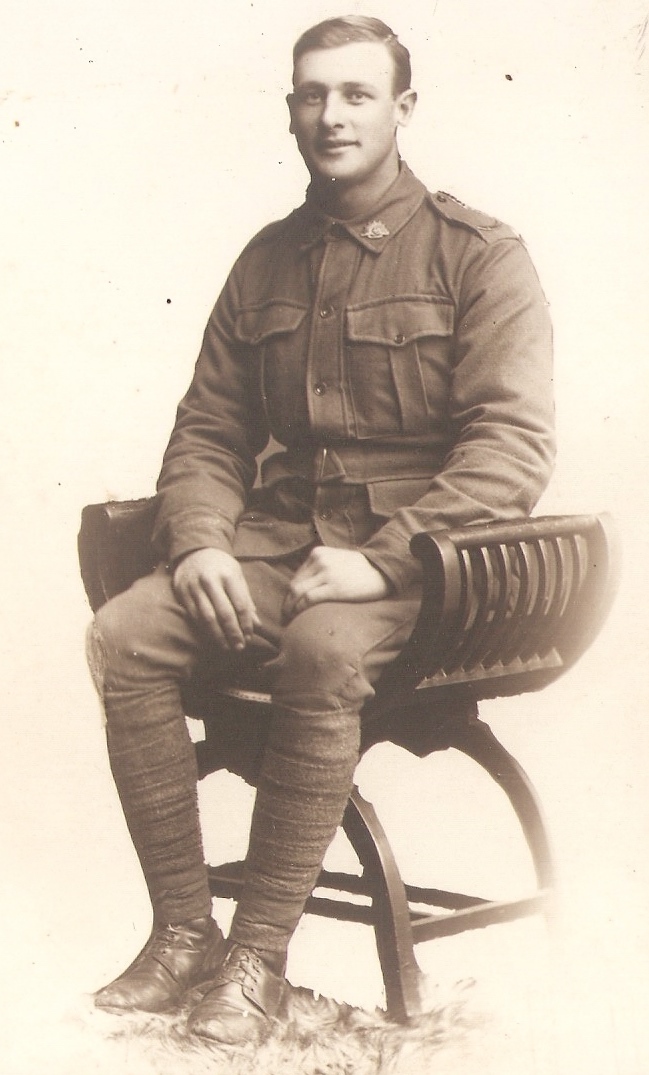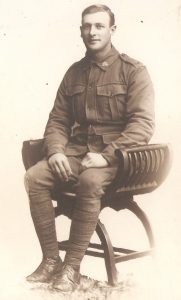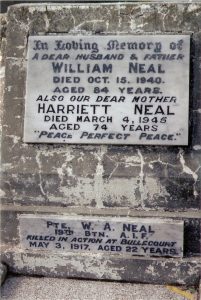William Arthur Neal was born in Orange in 1896, the third of nine children of William Thomas Neal and his wife Harriett Jane (nee Price). The Neal family lived on Cargo Road and William attended Nashdale Public School and later Orange Public School. He also served for three years in the 9th Light Horse in Orange.
In May 1916, aged 20, William enlisted in WWI. Being under 21 years of age it was necessary for William to have his parents’ written permission. He joined the 19th Battalion, 16th Reinforcement and attended Dubbo, then Liverpool training camp. On 7 October 1916 Private William Neal and his cousins, William James Bennett and Arthur Edward Neal, embarked HMAT A40 Ceramic in Sydney for overseas service. They disembarked in Plymouth on 21 November and proceeded to Folkestone camp.
In late December 1917 Private Neal was marched in to the 2nd Australian Divisional Base Depot at Etaples in France. At 3.45am on 3 May 1917 the Australian 2nd Division and the British 62nd Division launched an attack on the Hindenburg Line with the intention of securing the fortified village of Bullecourt. Soldiers of the 19th Battalion, William included, were engaged in the battle. They managed to penetrate the German line but met determined resistance. It was here that Private Neal was killed in action; one of 12 men from the Orange district who were killed that day during the disastrous Second Battle of Bullecourt. The offensive lasted two weeks, with Australian casualties numbering almost 7,500, for no military advantage.
Following his death William’s mother, Harriett, later received a letter from Lance-Corporal Lowcock, who was with William in his final moments:
Dear Mrs Neal,
I am forwarding you your poor son’s pocket book, which I got off him on May 3rd, 1917. We ‘went over’ on an attack that morning on Reincourt, and just after passing through the enemy’s barbed-wire entanglements I got wounded in both legs, so I crawled back to the centre of the wire, and saw someone lying in a shell-hole, badly wounded, so I crawled to him and it turned out to be your son. I had a look for his wounds, and found he was wounded in the chest, so, with the help of a comrade, we bandaged him up and did all we could for him under the circumstances, but the poor boy passed away about half-an-hour later; so, as I knew I would be coming to England, I took his wallet to send you, and the rest of his belongings my mate took to hand to the Quartermaster. I ask you and his father, brothers and sisters to accept my heartfelt sympathy in this hour of extreme sorrow, but you will always have the knowledge that your boy died bravely and honorably, facing the enemy to the last.
Yours sincerely, Lance-Corp. E. Lowcock
In July 1917 a tree was planted at Orange Public School in William’s memory. It was one of 26 trees planted in honour of fallen soldiers who had attended the school.
In February 1918 a service was held at the Canobolas Church of England to dedicate a white stone font to William’s memory, a gift to the church from his parents.
On the anniversary of their son’s death William’s parents inserted the following notice in the Leader:
He sleeps beside his comrades,
In a hallowed grave unknown,
But his name is written in letters of love
On the hearts he left at home.
In 1923 the Anzac Memorial Avenue of trees was planted along Bathurst Road to commemorate fallen WWI soldiers. A tree was planted in honour of “Pte WA Neal”; it was donated by Stan J Hicks. Very few of the trees are still standing today.
William Arthur Neal is commemorated on the Holy Trinity Church Orange Honour Roll, Nashdale Public School Honour Roll and Borenore and District Honor Roll. He is also commemorated on his parents’ headstone in Orange Cemetery, Church of England Section X, Grave 70. William’s name appears on the World War I Roll of Honour on the southern face of the Orange Cenotaph, on panel number 89 on the Roll of Honour at the Australian War Memorial in Canberra and on the Australian National Memorial at Villers-Bretonneux in France.



